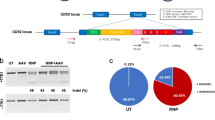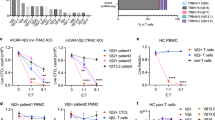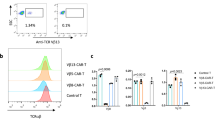Abstract
The calreticulin (CALR) exon 9 mutations are found in ∼30% of patients with essential thrombocythemia and primary myelofibrosis. Recently, we reported spontaneous immune responses against the CALR mutations. Here, we describe that CALR-mutant (CALRmut)-specific T cells are able to specifically recognize CALRmut cells. First, we established a T-cell culture specific for a CALRmut epitope. These specific T cells were able to recognize several epitopes in the CALRmut C terminus. Next, we established a CALRmut-specific CD4+ T-cell clone by limiting dilution. These CD4+ T cells recognized autologous CALRmut monocytes and hematopoietic stem cells, and T-cell recognition of target cells was dependent on the presence of CALR. Furthermore, we showed that the CALRmut response was human leukocyte antigen (HLA)-DR restricted. Finally, we demonstrated that the CALRmut-specific CD4+ T cells, despite their phenotype, were cytotoxic to autologous CALRmut cells, and that the cytotoxicity was mediated by degranulation of the T cells. In conclusion, the CALR exon 9 mutations are targets for specific T cells and thus are promising targets for cancer immune therapy such as peptide vaccination in patients harboring CALR exon 9 mutations.
This is a preview of subscription content, access via your institution
Access options
Subscribe to this journal
Receive 12 print issues and online access
$259.00 per year
only $21.58 per issue
Buy this article
- Purchase on Springer Link
- Instant access to full article PDF
Prices may be subject to local taxes which are calculated during checkout








Similar content being viewed by others
References
Dunn GP, Bruce AT, Ikeda H, Old LJ, Schreiber RD . Cancer immunoediting: from immuno- surveillance to tumor escape. Nat Immunol 2002; 3: 991–998.
Olivera F . Cancer Immunology. N Engl J Med 2008; 358: 2704–2715.
Coulie PG, Van den Eynde BJ, van der Bruggen P, Boon T . Tumour antigens recognized by T lymphocytes: at the core of cancer immunotherapy. Nat Rev Cancer 2014; 14: 135–146.
Schumacher TN, Schreiber RD . Neoantigens in cancer immunotherapy. Science 2015; 348: 69–74.
Campbell PJ, Green AR . The myeloproliferative disorders. N Engl J Med 2006; 355: 2452–2466.
Kralovics R, Passamonti F, Buser AS, Teo S, Tiedt R et al. A gain-of-function mutation of JAK2 in myeloproliferative disorders. N Engl J Med 2005; 352: 1779–1790.
Klampfl T, Gisslinger H, Harutyunyan AS, Nivarthi H, Rumi E, Milosevic JD et al. Somatic mutations of calreticulin in myeloproliferative neoplasms. N Engl J Med 2013; 369: 2379–2390.
Nangalia J, Massie CE, Baxter EJ, Nice FL, Gundem G, Wedge DC et al. Somatic CALR mutations in myeloproliferative neoplasms with nonmutated JAK2. N Engl J Med 2013; 369: 2391–2405.
Holmstrom MO, Riley CH, Svane IM, Hasselbalch HC, Andersen MH . The CALR exon 9 mutations are shared neoantigens in patients with CALR mutant chronic myeloproliferative neoplasms. Leukemia 2016; 30: 2413–2416.
Packer R, Bolton B Immortalization of B lymphocytes by Epstein Barr virus. In: Celis JE (ed) Cell Biology: A Laboratory Handbook, 2nd edn. Academic Press: San Diego, CA, USA, 1998; pp 178–185.
Pietra D, Rumi E, Ferretti VV, Di Buduo CA, Milanesi C, Cavalloni C et al. Differential clinical effects of different mutation subtypes in CALR-mutant myeloproliferative neoplasms. Leukemia 2015; 30: 1–8.
Moodie Z, Price L, Gouttefangeas C, Mander A, Janetzki S, Löwer M et al. Response definition criteria for ELISPOT assays revisited. Cancer Immunol Immunother 2010; 59: 1489–1501.
Takeuchi A, MESG Badr, Miyauchi K, Ishihara C, Onishi R, Guo Z et al. CRTAM determines the CD4+cytotoxic T lymphocyte lineage. J Exp Med 2016; 213: 123–138.
Perez-Diez A, Joncker NT, Choi K, Chan WFN, Anderson CC, Lantz O et al. CD4 cells can be more efficient at tumor rejection than CD8 cells. Blood 2007; 109: 5346–5354.
Silver RT, Kiladjian J-J, Hasselbalch HC . Interferon and the treatment of polycythaemia vera, essential thrombocytemia and myelofibrosis. Exp Hematol 2013; 6: 1–10.
Cassinat B, Verger E, Kiladjian J-J . Interferon alfa therapy in CALR-mutated essential thrombocythemia. N Engl J Med 2014; 371: 188–189.
Verger E, Cassinat B, Dosquet C, Giraudier S . Clinical and molecular response to interferon- a therapy in essential thrombocythemia patients with CALR mutations. Blood 2015; 126: 2585–2592.
Kjær L, Cordua S, Holmström MO, Thomassen M, Kruse TA, Pallisgaard N et al. Differential dynamics of CALR mutant allele burden in myeloproliferative neoplasms during interferon alfa treatment. PLoS ONE 2016; 11: e0165336.
Kiladjian J-J, Giraudier S, Cassinat B . Interferon-alpha for the therapy of myeloproliferative neoplasms: targeting the malignant clone. Leukemia 2015; 30: 1–6.
Riley CH, Brimnes MK, Hansen M, Jensen MK, Hasselbalch HC, Kjaer L et al. Interferon-α induces marked alterations in circulating regulatory T cells, NK cell subsets, and dendritic cells in patients with JAK2V617F-positive essential thrombocythemia and polycythemia vera. Eur J Haematol 2016; 97: 83–92.
Riley CH, Jensen MK, Brimnes MK, Hasselbalch HC, Bjerrum OW, Straten PT et al. Increase in circulating CD4+CD25+Foxp3+ T cells in patients with Philadelphia-negative chronic myeloproliferative neoplasms during treatment with IFN-α. Blood 2011; 118: 2170–2173.
Riley CH, Hansen M, Brimnes MK, Hasselbalch HC, Bjerrum OW, Straten PT et al. Expansion of circulating CD56(bright) natural killer cells in patients with JAK2-positive chronic myeloproliferative neoplasms during treatment with interferon-α. Eur J Haematol 2015; 94: 227–234.
Skov V, Riley CH, Thomassen M, Larsen TS, Jensen MK, Bjerrum OW et al. Whole blood transcriptional profiling reveals significant down-regulation of human leukocyte antigen class I and II genes in essential thrombocythemia, polycythemia vera and myelofibrosis. Leuk Lymphoma 2013; 54: 2269–2273.
Skov V, Riley CH, Thomassen M, Kjær L, Stauffer Larsen T, Bjerrum OW et al. The impact of interferon-alpha2 on HLA genes in patients with polycythemia vera and related neoplasms. Leuk Lymphoma 2017; 58: 1914–1921.
Tian Y, Sette A, Weiskopf D . Cytotoxic CD4 T cells: differentiation, function, and application to dengue virus infection. Front Immunol 2016; 7: 1–9.
Andersen MH, Bonfill JE, Neisig A, Arsequell G, Sondergaard I, Valencia G et al. Phosphorylated peptides can be transported by TAP molecules, presented by class I MHC molecules, and recognized by phosphopeptide-specific CTL. J Immunol 1999; 163: 3812–3818.
Chachoua I, Pecquet C, El-Khoury M, Nivarthi H, Albu RI, Marty C et al. Thrombopoietin receptor activation by myeloproliferative neoplasm associated calreticulin mutants. Blood 2016; 127: 1325–1335.
Obeid M, Tesniere A, Ghiringhelli F, Fimia GM, Apetoh L, Perfettini J-L et al. Calreticulin exposure dictates the immunogenicity of cancer cell death. Nat Med 2007; 13: 54–61.
Wang JC, Kundra A, Andrei M, Baptiste S, Chen C, Wong C . Myeloid-derived suppressor cells in patients with myeloproliferative neoplasm. Leuk Res 2016; 43: 39–43.
Munder M . Arginase: an emerging key player in the mammalian immune system. Br J Pharmacol 2009; 158: 638–651.
Boussiotis VA . Molecular and biochemical aspects of the PD-1 checkpoint pathway. N Engl J Med 2016; 375: 1767–1778.
Acknowledgements
We thank laboratory technician Merete Jonassen for outstanding help in teaching MOH to perform the immune cell assays and Tina Seremet for help with the analysis of T-cell receptors. We also thank the secretaries, nurses and laboratory technicians at University Hospital Zealand for organizing blood draws from patients. This study was supported in part by grant from Danish Cancer Society to HCH (Grant Number R90-A6143-14-S2) and by grants from Region Sjællands Sundhedsvidenskabelige Forskningsfond to MOH (Grant Numbers 12-000095 and 15-000342) in addition to support from Herlev Hospital.
Author information
Authors and Affiliations
Corresponding author
Ethics declarations
Competing interests
The authors declare no conflict of interest. However, it should be noted that Morten Orebo Holmström, Hans Carl Hasselbalch and Mads Hald Andersen have filed a patent regarding the CALR exon 9 mutations as a target for cancer immune therapy. The patent has been transferred to University Hospital Zealand, Zealand Region, and Copenhagen University Hospital at Herlev, Capital Region, according to Danish Law concerning inventions made at public research institutions.
Additional information
Supplementary Information accompanies this paper on the Leukemia website
Rights and permissions
About this article
Cite this article
Holmström, M., Martinenaite, E., Ahmad, S. et al. The calreticulin (CALR) exon 9 mutations are promising targets for cancer immune therapy. Leukemia 32, 429–437 (2018). https://doi.org/10.1038/leu.2017.214
Received:
Revised:
Accepted:
Published:
Issue Date:
DOI: https://doi.org/10.1038/leu.2017.214
This article is cited by
-
Tumor microenvironment antigens
Seminars in Immunopathology (2023)
-
Neoantigen-specific TCR-T cell-based immunotherapy for acute myeloid leukemia
Experimental Hematology & Oncology (2022)
-
Calreticulin and cancer
Cell Research (2021)
-
Cytotoxic T cells isolated from healthy donors and cancer patients kill TGFβ-expressing cancer cells in a TGFβ-dependent manner
Cellular & Molecular Immunology (2021)
-
EZH2 knockdown in tamoxifen-resistant MCF-7 cells unravels novel targets for regaining sensitivity towards tamoxifen
Breast Cancer (2021)



